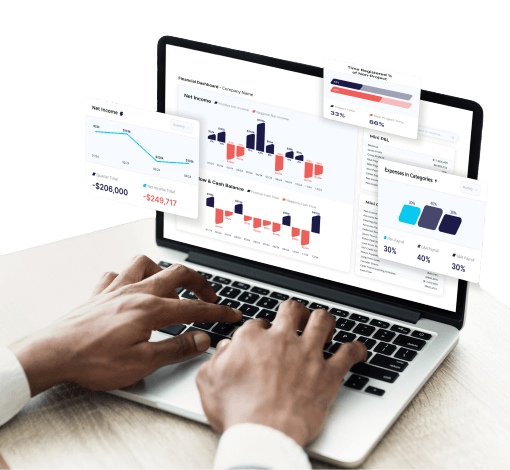Contribution Margin: The Key to Understanding Profitability
/Contribution%20Margin.png)
Key Points
Contribution margin (revenue minus variable costs) reveals true product profitability beyond traditional COGS and gross margin calculations.
Variable costs include both product-related expenses and operational costs like marketing, shipping, and sales commissions.
Regular analysis of contribution margins helps identify most profitable products and guides strategic business decisions.
Contribution Margin is key to improving your margins, particularly when evaluating different product lines. This article focuses on CM for inventory-based businesses, but the concept applies to SaaS and service-based businesses, to help you maximize profits and underperforming items.
Variable costs provide insights into improving your margins, particularly when evaluating different product lines.
Broadly, the definition of CM is "revenue minus variable costs." What makes it difficult to calculate is that variable costs can be hard to distinguish from fixed costs. Moreover, CM varies from one product or service line to another. As hard as it can be to make those determinations, though, they can also provide the most critical metric for measuring your company's true financial health.
This article focuses on CM for inventory-based businesses, but the concept applies to SaaS and service-based businesses with just minor differences in the recipe and labeling of inputs.
Profitability: COGS is a starting point — not a final analysis
When evaluating profitability, cost of goods sold (COGS) is a common place to start. Most business leaders are familiar with the term, although they might not be able to fully define it.
Inventory-based businesses that sell goods record their product sourcing and manufacturing costs as COGS, while businesses that sell services instead of goods commonly drop the word 'goods' from the name of this financial category, using the term cost of sales, or sometimes more literally, cost of service, both abbreviated as COS in place of COGS. This article double-clicks into COGS and COS concepts across different business types, unpacking the how and why with practical examples.
Profits and Margins
Without going down another rabbit hole into the difference between gross and net revenue (where net revenue is the result of subtracting certain discounts from the original full sales price of an item) COGS subtracted from revenue generally equals gross profit. And gross margin (GM) is a percentage that simply represents gross profit divided by revenue. These are basic barometers of your company's financial health — the higher your gross margin percentage is, the more gross profit you retain from each product sold.
If you look at the income statement (aka profit and loss statement, or P&L for short) of an inventory-based business, you'll notice that revenue or income appears at the top, followed by COGS, then the difference between the two is shown in the gross profit line.
The next section is usually labeled as selling, general, and administrative expenses (SG&A), operating expenses, or otherwise simply overhead. Those are the costs necessary to operate the rest of the business once it has products in retail packaging and ready for sale.
Operating profit or operating income is what's left after subtracting operating expenses from gross profit, and maximizing those profits is a primary objective of most business.
To further confuse the issue, operating expenses include both fixed and variable expenses. Some operating expenses, such as rent, insurance and other general overhead spend, tend to remain relatively fixed, regardless of how many or how few products are sold each month. Meanwhile, other SG&A costs, such as sales commissions and some of the other direct costs outlined above like outbound shipping costs, vary in direct proportion to changes in sales volume.
See where this is headed? Recognizing the nuances between COGS and operating expenses — and at an even more granular level, between fixed costs and variable costs — is the key to understanding CM.
Welcome to the murky world of contribution margin
While there isn't a line item for CM on a typical P&L, a detailed analysis of the variable costs associated with every product line can reveal critical differences in relative levels of profitability. This is important to consider in pursuit of maximizing company profitability at scale.
Simply put, CM for a given product can be determined by subtracting variable costs specific to that product from revenue. If you make $20k income per pallet of candy bars and your COGS were $8k, that leaves $12k gross profit per pallet, or 60% GM. Subtract another $7k variable costs to market, sell, deliver and get paid by your customer for the purchase of the full pallet worth of products (including direct marketing spend, sales commissions and the cost of the pallet itself, outbound freight, etc.), and your CM is $4k — or 20% of income.
Although there is no hard-and-fast percentage that determines break-even across every industry, the higher the percentage, the better. Targeted digital marketing spend often puts the biggest dent in CM for direct-to-consumer ecommerce sellers, for example, sometimes costing even more than product COGS itself. Fierce competition in some product categories can drive marketing costs so high that it causes CM to go negative, meaning that the more of that product a company sells, the more money they lose.
Understanding the true CM for each product empowers business leaders to make smart decisions that maximize company-wide operating profits. Tweaking your sales and marketing strategy to pour more resources into the most lucrative products while de-emphasizing less profitable items — or eliminating them entirely — can provide a huge boost to your bottom line. This same analysis can also indicate which product lines are in critical need of a price increase or shine a spotlight on inefficient operating costs, such as excess inventory storage costs that are draining margin from what would otherwise be very profitable products.
Don’t go it alone. Contact our expert accountant professionals.
Properly determining CM for your overall business as well as every individual product line is a painstaking exercise that requires meticulous recordkeeping and a high level of accounting expertise. But it is the only way to see your business as it really is and should be reviewed frequently to adjust for variable expenses that can fluctuate over time.
You don't have to do it alone, and it doesn't have to feel like brain damage each time through! Experienced and thoughtful accounting professionals should be able to set up your recordkeeping systems and workflows to bake these calculations into the regular monthly financial reporting cycle. More sophisticated teams can even track these metrics on a daily basis and also incorporate them into financial forecast models, cash flow forecasts and other management decision-support tools.


/Multi%20Entity%20ERP%20Implementation-Enterprise%20Financial%20Dashboard%20for%20Executives_1200x630.webp)
